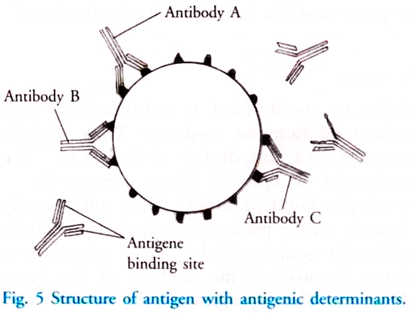In this article we will discuss about the structure of antigens with the help of suitable diagrams.
Acquired immunity only develops after invasion by a foreign organism or toxin. Each organism or toxin contains at least one special chemical compound that is different from other compounds. In general, these are proteins or large polysaccharides and these compounds initiate acquired immunity. These are called antigens. The response of the body to the presence of any foreign agent (antigen) is called immune response.
Antigens are defined as substances, which induce an immune response. They include proteins, carbohydrates and lipids. The molecular weight of these compounds is generally 8000 or more. Also, antigenicity depends on the presence of regularly recurring molecular groups called epitopes or antigenic determinants on the surface of the large molecule.
Thus epitopes are the smallest unit of an antigen to which an antibody or cell can bind. For a protein, an antibody binds to an epitope, which is about three to six amino acid long while for a carbohydrate it is about five to six sugar residues. Thus, a large antigen possesses many antigenic determinants that may be identical or different from each other per molecule (Fig. 5).
All antigenic determinants in an antigen are not equal. Some may elicit strong and others weak responses. This is determined by the health, age and genetic constitution of the individual.
Sometimes a low molecular weight compound called haptens can also elicit an immune response. But it cannot do it alone. It has to combine with another compound that is antigenic to bring about a reaction. Haptens are certain drugs, chemical constituents in dust, industrial chemicals, etc.
When a specific antigen comes in contact with T and B-cells in the lymphoid tissues, certain T-cells form activated T-cells and certain B-cells become activated to produce antibodies.
These cells start dividing to produce many copies. The lymphocytes that are capable of forming one specific kind of antibody are called the clone of B lymphocytes, or one type of T-cells with a single type of specificity are called a clone of T lymphocytes. Each clone of lymphocyte is specific to only a single type of antigen or similar antigens.
The clone of B cells secrete a specific type of antibody, which circulate through the body, while the clone of T-cells are released into the lymph, carried to the blood and circulated through all the tissue fluid and back into the lymph. They can circulate around and around in this circuit for months or years.

